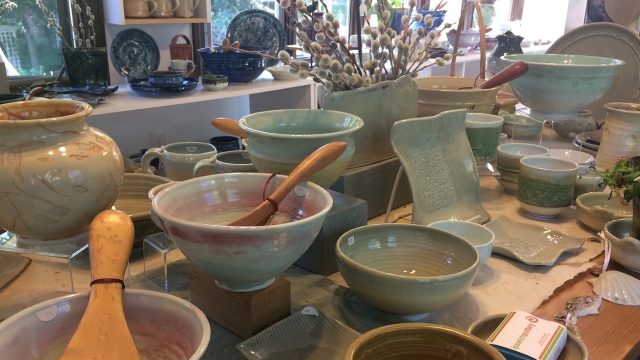
Pottery is more than just a craft; it is an age-old tradition that bridges art and functionality. Each piece tells a story, shaping not only the clay itself but also the dreams and inspirations of the artist who molded it. The alchemy of transforming raw materials into stunning creations involves both skill and creativity, as potters manipulate form and color to evoke emotion or serve a purpose. From delicate teacups to grand vases, the possibilities are endless when one immerses themselves in the world of pottery.
Living Room Lamps
In the heart of this enchanting craft lies Amitābha Studio, a haven for those who appreciate the beauty of unique, one-of-a-kind lamps. Crafted from antique and vintage Delft as well as other exquisite Dutch and Belgian pottery, these lamps illuminate not only a room but also the rich history and artistry that each piece represents. The artistry of pottery transcends mere decoration; it becomes a conduit for dreams, inviting warmth and personality into any space. As we explore this captivating realm, we celebrate the creativity and skill that define the delicate balance between art and alchemy in pottery.
The History of Delft Pottery
Delft pottery, renowned for its distinctive blue and white designs, originated in the city of Delft in the Netherlands during the late 16th century. As potters sought to replicate the famous blue and white porcelain from China, they developed their own unique style using earthenware as a base. This new pottery quickly gained popularity due to its affordability and decorative beauty, making it accessible to a wider audience. By the 17th century, Delftware had become a symbol of Dutch art and craftsmanship, often featuring intricate scenes of landscapes, flowers, and historical events.
The success of Delft pottery was intricately linked to the Dutch Golden Age, a period marked by extraordinary wealth and cultural flourishing. As trade routes expanded and the middle class grew, demand for decorative and utilitarian wares soared. Artisans in Delft began to meld influences from various sources, including Italian maiolica and Chinese porcelain, leading to the creation of pieces that were both functional and visually stunning. The craftsmanship in the blue and white designs became a hallmark of Dutch identity, elevating Delftware to a respected art form admired across Europe.
Throughout the centuries, Delft pottery has evolved, adapting to changing tastes and artistic movements. In the 18th and 19th centuries, new colors and patterns emerged as artists experimented with glazes and techniques. While traditional motifs remain prevalent, modern interpretations of Delft pottery have breathed new life into the craft, allowing it to thrive in contemporary art and design. Today, the legacy of Delft pottery continues in innovative studios like Amitābha Studio, where antique and vintage pieces are transformed into unique lamps, bridging the gap between history and modern aesthetics.
Unique Lamp Designs at Amitābha Studio
At Amitābha Studio, each lamp is a testament to the creativity and craftsmanship that can arise from the fusion of antique and vintage pottery. The studio curates a breathtaking selection of Delft and other Dutch and Belgian pieces, each meticulously chosen for its unique character and history. These lamps are not just lighting fixtures; they are storytelling artifacts, providing an elegant and artistic touch to any space.
The design process at Amitābha Studio celebrates individuality, resulting in one-of-a-kind lamps that captivate with their vibrant colors and intricate patterns. Artisans transform each pottery piece into a functional work of art, showcasing the rich cultural heritage and craftsmanship associated with traditional ceramics. The lights cast a warm glow, enhancing their beauty while inviting admiration from all who encounter them.
In addition to their aesthetic appeal, the lamps are designed with versatility in mind, making them suitable for various living spaces. Whether placed in a cozy reading nook or as a statement piece in a grand living room, the unique designs encourage personal expression and elevate interior decor. At Amitābha Studio, every lamp embodies a blend of history and innovation, making them perfect for those seeking to illuminate their dreams with artistry.
Sourcing Antique Pottery
Finding antique pottery requires a keen eye and a passion for history. Collectors often scour flea markets, estate sales, and antique shops in search of hidden gems. Each piece tells a story, reflecting the craftsmanship and culture of its time. Knowledge of different styles and manufacturers can aid in identifying valuable items, as well as understanding the significance of the materials used in their creation.
One notable source of inspiration is the Dutch and Belgian pottery, particularly Delftware, known for its distinctive blue and white designs. Sourcing these pieces involves exploring both local and international markets. Online auctions and specialized antique fairs also present opportunities to discover rare items. Building relationships with dealers who specialize in vintage pottery can enhance one’s collection by providing access to exclusive finds.
Amitābha Studio embraces this journey by carefully selecting unique pieces that resonate with the spirit of craftsmanship. By prioritizing quality and authenticity in their lamps, they are able to honor the art of pottery while giving new life to these antique treasures. Each lamp not only serves as a functional object but also as a conversation starter, inviting others to appreciate the beauty found in these timeless works of art.
The Craftsmanship Behind Each Piece
At Amitābha Studio, the artistry of pottery transcends mere function; it is an exploration of heritage and creativity. Each lamp is meticulously crafted from antique and vintage Delft and other Dutch and Belgian pottery, often carrying its own story and history. The selection process is a crucial part of creation, where the artists carefully choose pieces that not only resonate aesthetically but also connect with the legacy of craftsmanship that has been passed down through generations.
Once selected, the transformation of these pottery pieces begins. Artisans at the studio employ traditional techniques, combining their skills with modern innovations to breathe new life into each item. This careful process involves preserving the intricate designs and patterns that define Delftware while seamlessly integrating new functionalities. The commitment to detail ensures that every lamp is not just a lighting fixture but a piece of art imbued with character and charm.
The final touch involves an appreciation for the interplay of light and form. The lamps, while honoring their historical roots, are designed to reflect contemporary tastes and enhance the spaces they inhabit. Each piece, with its unique design, serves as a conversation starter, illuminating rooms not just with light, but with the spirit of artistry and craftsmanship that defines Amitābha Studio’s work. The result is a collection of lamps that are truly one-of-a-kind, celebrating the alchemy of turning clay into dreams.
Transforming Spaces with Artful Lighting
Lighting plays a pivotal role in setting the ambiance of any space, and unique lamps crafted from antique and vintage pottery can elevate this experience to new heights. Each lamp from Amitābha Studio is not simply a source of light; it is a work of art that tells a story and brings a touch of history into contemporary living environments. The intricate designs of Delft and other Dutch and Belgian pottery resonate with the charm of bygone eras, while their functionality transforms rooms into cozy retreats.
The selection of lamps offers versatility to suit a range of interior styles, from classic to modern aesthetics. Incorporating these artful pieces into home decor allows for an expression of individuality, turning standard lighting into a conversation starter. Each lamp’s distinctive character can harmonize with existing furniture or provide a striking focal point, casting warm, inviting light that enhances the overall atmosphere of the space.
In addition to their visual appeal, these pottery lamps serve as a reminder of the craftsmanship and artistry that goes into pottery. By choosing a lamp that combines functionality with artistry, one embraces the essence of handmade goods and supports sustainable practices. The interplay of light and clay not only illuminates spaces but also inspires a deeper appreciation for the beauty of creativity in everyday life.


